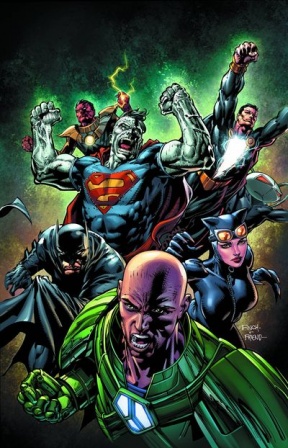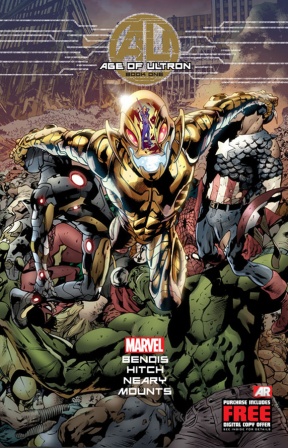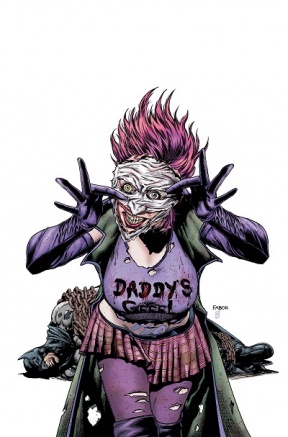Is there some consensus on why comics sales are down this year? Is it shops closing or people switching to digital or what?
— Ed Brubaker (@brubaker) April 4, 2014
My books sell exactly the same as last year, and trades are selling better than they ever have and most of my friends books are the same way
— Ed Brubaker (@brubaker) April 4, 2014
So where’s the bleeding coming from?
— Ed Brubaker (@brubaker) April 4, 2014
Ed Brubaker, as he is wont to do, brought up an interesting point in a series of tweets, responding to the release of March’s sales from Diamond Comic Distributors. It certainly got people talking, and wondering similar things. Why are the industry’s sales flagging right now? What is driving down sales industry wide?
Those sales charts led to a lot of doom and gloom, with pundits labeling sales as “blah” and “anemic” and people on Twitter generally worrying about the reversal of the steady and occasionally shocking growth of the comic industry. Just look at the sales numbers (per Comichron, and looking only at Dollar amounts throughout this piece) and you can see what people are talking about:
– March 2014 vs. March 2013: -1.48%
– Q1 2014 vs. Q4 2013: -13.45%
– Q1 2014 vs. Q1 2013: -4.40%
That’s a whole lot of downward trending on every level you can really look at, and naturally, people began to throw out ideas as to what caused the downturn. Event fatigue? Digital? Pricing? You name it, people threw it out there.
But for me, my reaction was to wonder whether it’s really a dire situation, or one in which the combination of unpredictable factors and simple poor timing have manufactured a short-term downward trend. I think it’s the latter, and I’ll explain why I not only think that’s the case, but why the rest of 2014 will have people changing their tune very quickly.
But first…
The Prevailing Theories
There were a lot of ideas bandied about in response to Brubaker’s tweets and in the general comic fan and pundit populace. As with most internet talk, there were some good points and some that missed the mark, but before I get to what I believe is the real reason, I wanted to look at some of the theories that were brought up the most in response, and how they do or do not contribute to the first quarters week returns.

One of the most frequent theories thrown out on Friday, and one of the things that people always bring up when they’re talking about the comic industry performing poorly, is the idea of publishing or event fatigue. It’s always that readers are dropping off because too many titles are being released or too many events or crossovers. It’s an understandable idea, as events have gone from something people were extremely excited about in the 1990’s to something fans find insufferable today.
But it’s also one that doesn’t really have a lot of weight when you look at the numbers. In fact, you could make a pretty good argument – and I will here in a little bit – that one of the main reasons why sales were down in March was due to the lack of events. The beginning of the year has been relatively event free, with only DC’s semi-successful but instantly forgettable “Forever Evil” appearing at local comic book shops.
Digital Cannibalizing Print
Everyone has thought that digital would be the end of print, and that it would begin to take away from print sales immediately. Years later, that idea has still yet to come to fruition, with most publishers finding that digital sales are additive rather than something that takes away from their print product. And after the nearly 300% growth in digital in 2012, most reports have shown that digital sales growth has decreased significantly, with iCV2’s yearly white paper reporting growth of a still excellent 25%. Even anecdotally, you can see that digital has slowed a bit. Last week, we ran an interview with Image publisher Eric Stephenson shared, “for a few years there was a real surge, but over 2013, it was just kind of the same as the year before.”
Continued belowWhen combined with the 9% overall print growth in 2013, you can extrapolate that this is something that isn’t really impacting the print market, at least not in a significant enough way to be causing this decrease.
Some brought up the idea that the vaunted “Polar Vortex” could have impacted print sales, driving readers to either read digitally or wait for trade. While that’s certainly possible, there’s no real data that suggests that as something that really happened, especially considering sales were up during the Vortex’s prime in Q4 of 2013 (a period Comichron’s John Jackson Miller described as “best quarter of the Diamond Exclusive Era”), and the fact that sales aren’t driven by actual fan purchases but by retailer orders which are put in three months in advance.
Marvel #1’s: Your Perfect Jumping OFF Point
What if Marvel’s “All-New Marvel Now!” endeavor didn’t provide readers with jumping-on points like they planned, but perfect spots to drop a book? It’s an interesting idea, and one that some speculated as a potential contributing factor for the sales decrease.
However, it’s one I personally don’t see a lot of merit in, especially considering that two of those books opened in March’s top ten in sales (“Silver Surfer” and “Daredevil”) and that a large portion of those books didn’t even exist before the #1’s were released.

The new Marvel #1’s were never designed to be monumental hits, if only by their nature. Were they supposed to be exciting, quality new additions to Marvel’s line? Definitely. Were they ever earmarked as banner launches, save for a few? Not likely.
The incessant relaunches of titles is certainly obnoxious, but is that type of fatigue felt in the sales charts? Given that both “Wolverine” and “Fantastic Four” saw over 100% growth in orders between the finales of their previous volume in January and their relaunches in February, I’d say the answer to that question is a definite no.
Comics are getting too expensive!
Everyone – including me – has a hard time not looking back on yesteryear in comics with envy. Do you remember how it felt to spend $1.99 on a comic? Or even $2.99? It was amazing! Now, $3.99 is the norm, and many people think that is the ultimate reason for sales decreases.
And honestly, this one might have some truth to it. While between February of 2013 and 2014, the average cost of a comic only increase 3 cents from $3.62 to $3.65, orders on books being dropped because of price could be happening at a slowed rate due to the nature of how comics are ordered.
Think about it like this. Let’s say you’re a retailer and you’re putting in orders for the new “Moon Knight” comic. You’re going big because it’s Warren Ellis and Declan Shalvey and Jordie Bellaire and a new number one with a lot of hype. But then the comic comes in and your customers don’t buy it because it’s $3.99. What happens? You drop #4’s orders. Then you drop #5. Sales drop and drop, and there is a rolling effect felt in the industry that could be related to what we are seeing today.
While I don’t think that’s the case for “Moon Knight”, as both issues sold out completely at my shop, it could be the type of thing that is happening at a retailer level.
I emphasize could, because while I think it may be happening situationally, the fact is sales haven’t dropped that much, and I think we’d have felt it by now if this was going to be such a significant factor. It does underline that the way comics are ordered creates a place where it’s hard to predict sales data and really trend the way the industry is headed, but that’s another story for another time.
So Where the Bleeding is Coming From?
To that, I say “nowhere.”
Continued belowWell, there is a little bleeding, but for the vast majority of the industry, things are still rosy, and most of the downturn is a product of bad timing as much as anything.
Sure, there is a lot of bleeding in the sense that sales are down over the past few months, but a lot of the aforementioned doom and gloom stems from two levels of statistics, as from Q1 2014 to Q4 2013 sales were down a stunning 13.45%, while in Q1 2014 they were down 4.4% from Q1 2013. Those are shocking drops, but ones that – in my mind – are easily explained and not indicative of a change in overall market trend.
For the Q1 to Q4 part, yeah, 13.45% was a HUGE drop. A scary drop even. But here is where I bring back that quote from Comichron’s John Jackson Miller where he described the fourth quarter of 2013 as the “best quarter of the Diamond Exclusive Era.” After the biggest month or quarter or anything, it’s going to be hugely difficult to maintain or increase on that level. More than likely, you’ll see regression to the mean, and sales normalizing after a rather vaunted period.
Plus, comparing the fourth quarter to the following first quarter in any market is always a difficult one to make. It’s period where you’ll see decreases in sales, whether you’re talking movies or video games or comics, thanks to the holiday season passing and people simply having less available funds to spend. Q1 is traditionally as wintry as its weather.

That’s a Dream Team of Marvel and DC first quarter launches, at least in terms of guaranteeing high orders, and something that there was no way the first quarter this year could ever hang with even factoring in “All-New Marvel Now!” and “Forever Evil”.
In fact, while there was a decrease of 4.4% year-to-year in Q1, when you compare only the top ten’s of February 2013 and 2014, there was a staggering drop of 38.22%. I hate to call something like this a product of bad timing, but in a lot of ways, that’s what it was.
But I said there was a little bleeding. Where is that coming from? Well, let’s look at this little thing:

What I have graphed above is the market share in percentage of dollars the five biggest publishers have earned over the past six months. What you see is Marvel and Image jumping, IDW and Dark Horse staying steady…and DC steadily dropping for an overall decrease of 5.08%.
What does that mean?
Well, it could just be market fluctuation. Ultimately, the whole industry is down – which is where the concern came from – so what does the decrease in one publisher’s sales mean as a portion of a decreasing whole? A lot, actually.
Let’s revisit that Eric Stephenson interview again, as he said this about the industry:
“Having a Big Two is not a sign of a healthy industry. Any industry that is dominated by two businesses – whether you’re talking about comics or anything – that means if one of those businesses goes down, you’re fucked.”
That’s the most important part of that entire interview for this subject, and we’re already seeing that statement in action to a degree with this down period in comics. DC’s sales are waning – once again, down just over 5% from October of 2013 – even though in March they released 113 total comics versus 100 in October. They’re releasing more books than before, but their market share continues to drop, depressing the industry as a whole.
Continued below
I don’t even think it’s that wild. While I don’t have the full market numbers, I wouldn’t be surprised if when you broke it down, a significant portion of the overall decrease stems from DC’s first quarter performance.
Combine that with the uncanny quality of the first and fourth quarters of 2013, and you, my friends, have one iron clad explanation as to why sales are down in the first quarter of 2014, but maybe not down for the count.
The Future is Bright
Now that we know why sales are down, I have this to say: I think the rest of 2014 is going to be big, even for DC.
This week brings the launch of the first of three DC weekly series, and this one has their big gun in the name: Batman. “Batman Eternal” will act as a life preserver to DC’s flagging sales, with a perpetual infusion of Batfans bolstering their weekly, monthly and 2014 forecasts. With “The New 52: Future’s End” and a third unrevealed weekly arriving in 2014 as well, you’re taking flotsam and jetsam like “Stormwatch” and “Larfleeze” and replacing them with at least four books a month that will likely be in high demand.
Is that sort of like putting a bandaid on a leak on your sinking ship? Hell yes. Is it going to work, at least for now? You better believe it. Contrary to widely held beliefs, DC Comics is a smart company, and the move to weekly releases for some of their bigger characters and ideas instead of monthly issues of lower tier books is going to do a lot for their bottom line, and the overall (short term) health of the industry. If my wild theory is correct, it won’t resolve any of their long-term issues, but I expect a significant bounce back for DC in April and beyond.

Image, to name one smaller publisher, could see an even bigger market share bite come their way. 2014 will see the release of books from creators like Jason Aaron and Jason Latour, Scott Snyder and Jock, and Grant Morrison and Chris Burnham, and with big names will come big orders. On top of that, here’s my fearless prediction for the year: Sex Criminals, when it returns, will skyrocket in sales. The Brimper Army is growing, my friends, and I think 2014 will be even bigger for that book than 2013 was. And that’s saying something.
All the other publishers have things to hang their hat on, as well, with Valiant looking to take the leap with Valiant First, Dark Horse and IDW having an array of exciting releases, and Dynamite kicking it up a notch with some excellent looking books (including the stupendous looking “Flash Gordon” #1).
Even beyond what’s next on everyone’s publishing docket, people seemed to ignore two promising facts in the March sales announcement. For one, sales increased from March to February, implying that we’re already seeing a bit of a turnaround, and for another, trade sales continue to grow.
The latter point leads into one thing I didn’t discuss as an explanation for the decrease in floppy sales: the idea that trade waiters are growing in number. The reason I didn’t discuss it was because I don’t think that is necessarily impacting monthly sales of comics. However, I do think it is a very good thing, and that it might speak more to how easy they are for new readers to pick up and jump into versus monthly comics. Look back at the second tweet I shared from Brubaker, if you need any anecdotal proof of that.
Continued belowAsk anyone at Multiversity, and they’ll tell you I’m a glass half full kind of guy when it comes to these things. But this isn’t blind optimism. When you look at the cold hard facts and what’s on the horizon, it’s really difficult to not be excited about what’s coming for comics. Granted, I’m coming off a high from Emerald City ComiCon two weekends ago, where you couldn’t convince anyone that comics are in a down period, but from where I sit, the downturn in the first quarter of 2014 wasn’t a sign of ill tidings at all.
Quite the contrary, in fact.
I think it’s the outlier in what will be yet another prosperous year of growth in comics, for print, digital, trades and everything in-between.






